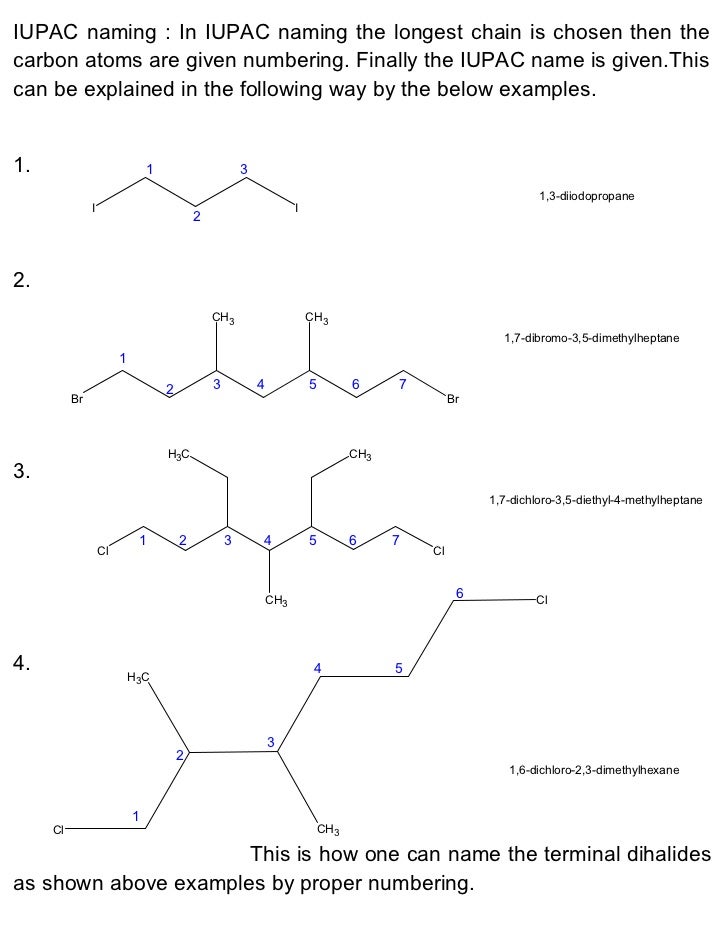-
Iupac Nomenclature Of Organic Molecules Pdf카테고리 없음 2020. 3. 1. 11:05
The prefix ' n-' (or normal) isused when all carbons form a continuous, chain. If a (such as an )is present that is on the end of the chain. Not to be confused with ',which indicates a missing.Common:n-:Common:n-:1-The prefix ' iso' is used when all carbons except one form acontinuous chain. This one carbon is part of an at the end of the chain.Common:iso:2-Common:iso:3-1-'Iso' can also indicate that theis an of anotherwith a common (or trivial) name.Common::-1,2-diCommon::-1,3-diThe prefix ' neo' is used when all but two carbons form acontinuous chain, and these two carbons are part of a terminal.Common:neo:2,2-diCommon:neo:2,2-di-1.



Organic NomenclatureNomenclatureNaming Organic CompoundsThe increasingly large number of organic compounds identified with each passing day, together with the fact that many of these compounds are isomers of other compounds, requires that a systematic nomenclature system be developed. Just as each distinct compound has a unique molecular structure which can be designated by a structural formula, each compound must be given a characteristic and unique name.As organic chemistry grew and developed, many compounds were given trivial names, which are now commonly used and recognized. Some examples are:NameMethaneButaneAcetoneTolueneAcetyleneEthyl AlcoholFormulaCH 4C 4H 10CH 3COCH 3CH 3C 6H 5C 2H 2C 2H 5OHSuch common names often have their origin in the history of the science and the natural sources of specific compounds, but the relationship of these names to each other is arbitrary, and no rational or systematic principles underly their assignments.
The IUPAC Systematic Approach to NomenclatureA rational nomenclature system should do at least two things. First, it should indicate how the carbon atoms of a given compound are bonded together in a characteristic lattice of chains and rings. Second, it should identify and locate any functional groups present in the compound. Since hydrogen is such a common component of organic compounds, its amount and locations can be assumed from the tetravalency of carbon, and need not be specified in most cases.The IUPAC nomenclature system is a set of logical rules devised and used by organic chemists to circumvent problems caused by arbitrary nomenclature.
Knowing these rules and given a structural formula, one should be able to write a unique name for every distinct compound. Likewise, given a IUPAC name, one should be able to write a structural formula. In general, an IUPAC name will have three essential features: A root or base indicating a major chain or ring of carbon atoms found in the molecular structure. A suffix or other element(s) designating functional groups that may be present in the compound. Names of substituent groups, other than hydrogen, that complete the molecular structure.As an introduction to the IUPAC nomenclature system, we shall first consider compounds that have no specific functional groups. Such compounds are composed only of carbon and hydrogen atoms bonded together by sigma bonds (all carbons are sp 3 hybridized).An excellent presentation of organic nomenclature is provided on a created by Dave Woodcock.A full presentation of the is also available.AlkanesAlkanesHydrocarbons having no double or triple bond functional groups are classified as alkanes or cycloalkanes, depending on whether the carbon atoms of the molecule are arranged only in chains or also in rings. Although these hydrocarbons have no functional groups, they constitute the framework on which functional groups are located in other classes of compounds, and provide an ideal starting point for studying and naming organic compounds. The alkanes and cycloalkanes are also members of a larger class of compounds referred to as aliphatic. Simply put, aliphatic compounds are compounds that do not incorporate any in their molecular structure.The following table lists the IUPAC names assigned to simple continuous-chain alkanes from C-1 to C-10.
Iupac Name List Pdf
A common 'ane' suffix identifies these compounds as alkanes. Longer chain alkanes are well known, and their names may be found in many reference and text books.
The names methane through decane should be memorized, since they constitute the root of many IUPAC names.